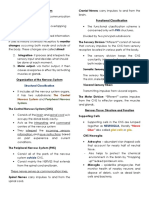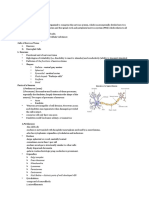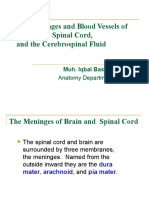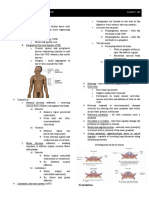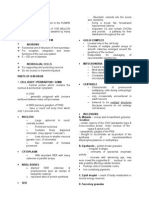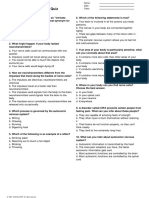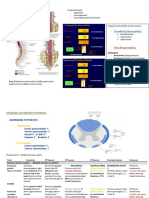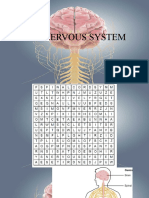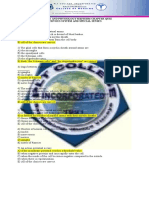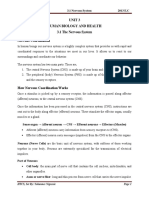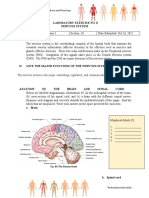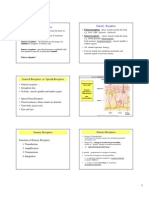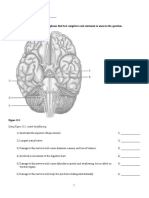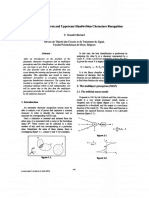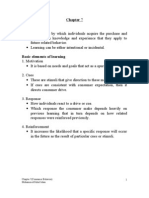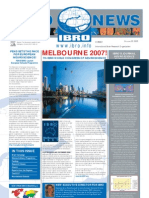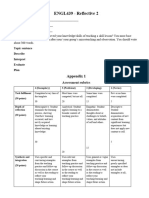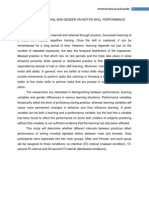Chapter 11: Fundamentals of the Nervous System and Nervous Tissue
Chapter 12: The Central Nervous System
Chapter 13: The Peripheral Nervous System and Reflex Activity
Chapter 14: The Autonomic Nervous System
THE NERVOUS SYSTEM
Master controlling and communicating system of the body
Works together with endocrine system to maintain homeostasis
Nervous system - quick response to stimuli
Endocrine system - slower but long lasting effects
Functions:
1. Monitor sensory input (information) from environment
2. Integrate the information
3. Response by activates the effector organ
ORGANIZATION OF THE NERVOUS SYSTEM
Structural
Divided into CNS (brain and spinal cord) and PNS (nerves and ganglia)
DIVISION OF NERVOUS SYSTEM
Nervous System
Central Nervous System Peripheral Nervous System
Functional
PNS subdivided into:
1. Sensory (afferent) division – conveys impulses to CNS
2. Motor (efferent) division – conveys impulses from CNS
Motor division includes:
a. Somatic (voluntary) division - innervates skeletal muscles
b. Autonomic (involuntary) division - innervates
smooth/cardiac muscle and glands
1
� Chapter 11: Fundamentals of the Nervous System and Nervous Tissue
Chapter 12: The Central Nervous System
Chapter 13: The Peripheral Nervous System and Reflex Activity
Chapter 14: The Autonomic Nervous System
NERVOUS TISSUE
Made up of 2 principal types of cells:
1. Neurons (nerves cells) - transmit electrical signals
2. Neuroglia or glial cells (supporting cells) - support, protect and nourish
the neurons
CNS neuroglia - astrocytes, microglia, ependymal cells
PNS neuroglia - schwann cells and satellite cells
Functions of Neuroglia
Neuroglia
CNS PNS
1. Provide framework for neuron 1. Produce fatty sheath
2. Remove unwanted materials around neuron axons
3. Aid in cerebrospinal fluid (Schwann cells)
circulation
Neurons
3 parts of neuron (nerve cell); cell body, dendrites and axon
1. Cell Body
Located in CNS
Receiving surface
Containing nucleus
2. Dendrites
Receive information from other neurons
Dendrites of motor neuron are short but many
Dendrites of sensory neuron are long
2
� Chapter 11: Fundamentals of the Nervous System and Nervous Tissue
Chapter 12: The Central Nervous System
Chapter 13: The Peripheral Nervous System and Reflex Activity
Chapter 14: The Autonomic Nervous System
3. Axon (Nerve Fibers)
Conduct impulse away from cell body
Short/long nerve fiber
Long fibers processes outside CNS covered by white myelin sheath
formed by Schwann cells and neurilemma sheath
Most large fiber are myelinated, myelin increases the rate of
nerve impulse transmission.
Gap in between form the nodes of Ranvier, nerve cell conduction
Synapse is a junction at axon ends to mediate information transfer
from one neuron to another
Classification of Neurons
1. Sensory neuron (afferent neuron)
Conduct impulse from sensory receptor to CNS
Long peripheral process
Unipolar
Cell body located in PNS
2. Motor neuron (efferent neuron)
Conduct impulse from CNS to effector organ (muscle/gland)
Short dendrite, long axon
Multipolar
Cell body in CNS
3. Interneuron (association neuron)
Conduct impulse within CNS
Short dendrite, axon long/short
Multipolar
Found in CNS
Properties of Neuron
1. Excitability (Irritable) - ability to respond to stimuli
2. Conductivity - ability to transmit signal
When neuron is stimulated, an electrical impulse is generated and
conducted along the length of its axon
This response called action potential (nerves impulse)
3
� Chapter 11: Fundamentals of the Nervous System and Nervous Tissue
Chapter 12: The Central Nervous System
Chapter 13: The Peripheral Nervous System and Reflex Activity
Chapter 14: The Autonomic Nervous System
ACTION POTENTIAL
Brief reversal of membrane potential with a total amplitude of ~100 mV
Occurs in muscle cells and axons of neurons
Principal means of long-distance neural communication
Generation of an Action Potential
1. Resting State
Resting membrane potential - approximately –70 mV
All Na+ and K+ channels are closed
2. Depolarization
Depolarizing local currents open Na+ channels
Na+ influx causes more depolarization
At threshold (–55 to –50 mV) positive feedback leads to opening of
all Na+ channels (inside become less negative)
3. Repolarization
Na+ channels inactivate
Membrane permeability to Na+ declines to resting levels
K+ channels open
K+ exits the cell and internal negativity is restored
4. Hyperpolarization
Some K+ channels remain open, allowing excessive K+ efflux
Na+ channels reset
THE CENTRAL NERVOUS SYSTEM
The Brain
4 divisions:
1. Cerebrum (Cerebral Hemispheres)
2. Diencephalon
3. Brainstem
a. Midbrain
b. Pons
c. Medulla oblongata
4. Cerebellum
4
� Chapter 11: Fundamentals of the Nervous System and Nervous Tissue
Chapter 12: The Central Nervous System
Chapter 13: The Peripheral Nervous System and Reflex Activity
Chapter 14: The Autonomic Nervous System
Cerebrum / Cerebral Hemispheres
Consists of 2 hemispheres; right and left
Cerebral hemispheres exhibit gyri /gyrus (elevated ridges of tissue), sulci
/sulcus (shallow grooves) and fissures (deep grooves)
Longitudinal fissure partially separates the hemispheres
Involved in logical reasoning, moral conduct, emotional responses, sensory
interpretations, and the initial of voluntary muscle activity
Surface of cerebrum is gray matter called the cerebral cortex
Divided into 5 lobes:
1. Parietal lobe
2. Frontal lobe
3. Temporal lobe
4. Occipital lobe
5. Insula - buried deep within the lateral sulcus and forms part of its floor
Functional areas of the cerebral cortex include:
1. Motor areas
2. Sensory areas
3. Association areas
Central sulcus separates the motor areas and sensory areas
Motor areas – control precise or skilled voluntary movements
Sensory areas – concerned with conscious awareness of sensation
Association areas – intellect, cognation, reasoning, judgment, etc
Cerebral hemispheres show lateralization of cortical function. In most people,
the left hemisphere is dominant (i.e., specialized for language and
mathematical skill), the right hemisphere is more concerned with visual-
spatial skills and creative endeavors
Beneath (interior) the cortex is cerebral white matter
Fiber tracts of the cerebral white matter include commissural fibers,
association fibers, and projection fibers
Deep within the cerebral white matter is the third basic region of each
hemisphere, a group of subcortical nuclei called basal nuclei
The pair basal nuclei help control muscular movements.
Parkinson’s disease and Huntington’s disease are disorders of the basal nuclei
Diencephalon
Located deep to the cerebrum
Connects the midbrain with the cerebral hemispheres
Composed of thalamus, hypothalamus and epithalamus
Thalamus - relay station for sensory impulses passing to the sensory
cortex for interpretation
Hypothalamus - autonomic control center, maintains water balance and
regulates thirst, eating behaviour, gastrointestinal activity, body
temperature and the activity of the anterior pituitary glands
Epithalamus - includes the pineal gland which secretes the melatonin
(helps regulate the sleep-wake cycle)
5
� Chapter 11: Fundamentals of the Nervous System and Nervous Tissue
Chapter 12: The Central Nervous System
Chapter 13: The Peripheral Nervous System and Reflex Activity
Chapter 14: The Autonomic Nervous System
Brainstem
Relays messages between the spinal cord and the cerebrum
1. Midbrain
Mainly fiber tracts
Connects the pons and cerebellum with the cerebrum
2. Pons
Connecting bridge between the medulla oblongata and the
midbrain
Has fiber tracts and nuclei involved in respiration
3. Medulla oblongata
Fibers of motor tracts from the motor cerebral cortex cross over
(decussate) in the medulla oblongata before entering the spinal
cord
Contains vital cardiac, vasomotor, and respiratory center
(breathing, HR, BP, etc,)
Regulates vomiting, sneezing, coughing, and swallowing
Cerebellum
Located behind the pons
Large and cauliflower-like
Mainly a coordination center for muscular movement, involved with balance,
precision, timing, and body position
Protection of the Brain
Protected by:
1. Bone
2. Meninges
3. Cerebrospinal fluid (CSF)
4. Blood-brains barrier
Meninges
Brain is covering by 3 layer protective membranes (connective tissues):
1. Dura mater
2. Arachnoid mater
3. Pia mater
Between the arachnoid and pia mater is the subarachnoid space, which
contains cerebrospinal fluid
6
� Chapter 11: Fundamentals of the Nervous System and Nervous Tissue
Chapter 12: The Central Nervous System
Chapter 13: The Peripheral Nervous System and Reflex Activity
Chapter 14: The Autonomic Nervous System
Cerebrospinal fluid/ CSF
Formed by the choroid plexus from blood plasma, circulates through the
ventricle and into the subarachnoid space
Supports and watery cushions the brain and spinal cord and helps to nourish
them
Blood-brain barrier
Reflects the relative impermeability of the epithelium of the capillaries of the
brain
It allows water, respiratory gases, essential nutrients, and fat-soluble
molecules to enter the neural tissue, but prevent entry of other, water-
soluble, potential harmful substances
The Spinal Cord
Gross Anatomy and Protection
Two-way impulse conduction pathway and a reflex center
Conducting impulse between brain and peripheral nerves
Connecting link between the brain and most of the body
Controls many reflex actions
Protected by bone (vertebral column), meninges, and cerebrospinal fluid
Extends from the foramen magnum to the end of the 1 st lumbar vertebra
31 pairs of spinal nerve roots issue from the cord
The cord is enlarged in the cervical and lumbar regions, where spinal nerves
serving the limbs arise
Cross-sectional Anatomy
‘H’ shaped gray matter surrounded by white matter
Axons of motor neurons emerge in common from the cord via ventral roots
Axons of sensory neurons enter the posterior aspect of the cord and form the
dorsal roots
The ventral and dorsal roots combine to form the spinal nerves
Conduction pathway comprised of:
1. Ascending tract
2. Descending tract
Ascending tract are made up of sensory fibers that carry impulse up the spinal
cord to the brain
Descending tract of motor fibers transmit impulse from the brain down the
spinal cord to the efferent neurons
All tracts are pair and decussate
7
� Chapter 11: Fundamentals of the Nervous System and Nervous Tissue
Chapter 12: The Central Nervous System
Chapter 13: The Peripheral Nervous System and Reflex Activity
Chapter 14: The Autonomic Nervous System
THE PERIPHERAL NERVOUS SYSTEM
Consists of sensory receptors, nerves conducting impulses to and from the
CNS, their associated ganglia, and motor endings
Nerves extend between skin, muscles, visceral organs and glands to and from
the CNS
Divided into somatic and autonomic nervous system
Prominent nerves involve are cranial and spinal nerves
Peripheral Nervous System
Autonomic Nervous System Somatic Nervous System
Sympathetic Division Parasympathetic Division
Sensory Receptors
Are specialized to respond to environmental changes (stimuli)
Simple (general) receptors for pain, touch, pressure, and temperature found
in the skin, skeletal muscles, tendons, and visceral organs
Complex receptors (sense organs) serve the special senses (vision, hearing,
equilibrium, smell, and taste)
Nerves and Associated Ganglia
A nerve is a bundle of neuron fibers in the PNS wrapped in connective tissue
covering
Each fiber is enclosed by an endoneurium, fascicle of fibers is wrapped by
perineurium, and the whole nerve is bundled by the epineurium
Ganglia are collections of neuron cell bodies associated with nerves in the
PNS; e.g.: the dorsal root (sensory) ganglia and autonomic (motor) ganglia
8
� Chapter 11: Fundamentals of the Nervous System and Nervous Tissue
Chapter 12: The Central Nervous System
Chapter 13: The Peripheral Nervous System and Reflex Activity
Chapter 14: The Autonomic Nervous System
Cranial Nerves
12 pairs
Originate from the brains
Innervate the head and neck
Only the vagus nerves (X) extend into the thoracic and abdominal cavities
Cranial nerves are numbered from anterior to posterior in order of
emergence from the brain
Their names reflect structures serves or function or both; e.g.:
Olfactory nerves (I) - sensory; carries impulses for the sense of smell
Optic nerves (II) - sensory; carries impulses for vision
Facial nerves (VII) - activate the muscles of facial expression and the
lacrimal and salivary glands; carries sensory impulses from the taste
buds of anterior tongue
Spinal Nerves
Consists of nerves extend between skin, muscles, visceral organs and glands,
CNS
Divided to somatic and autonomic system
There are 31 pairs of spinal nerves:
1. 8 cervical (C1 - C8)
2. 12 thoracic (T1 - T12)
3. 5 lumbar (L1 - L5)
4. 5 sacral (S1 - S5)
5. 1 coccygeal (C0)
Spinal nerves emerging from:
1. Cervical enlargement - innervate the upper limbs
2. Lumbar enlargement - innervate the lower limbs
Each spinal nerves divided into:
1. Ventral (anterior, motor) root - contain efferent nerve fibers and convey
motor information)
2. Dorsal (posterior, sensory) root - contain afferent nerves fibers, which
enter the cord with sensory information
Branches of each spinal nerve include dorsal and ventral rami, a meningeal
branch, and rami communicantes (ANS branches) in the thoracic region
Dorsal rami serve the muscles and skin of the posterior body trunk
Ventral rami (except T2 to T12 nerves) are arranged to form networks of
nerves called plexuses that serve the limbs
The intercostals nerves are the T2 - T12 spinal nerves (serve the thorax wall
and abdominal surface)
9
� Chapter 11: Fundamentals of the Nervous System and Nervous Tissue
Chapter 12: The Central Nervous System
Chapter 13: The Peripheral Nervous System and Reflex Activity
Chapter 14: The Autonomic Nervous System
The Reflex Arc
A reflex is a rapid, involuntary motor response to a stimulus
Has 5 elements:
1. Receptor
2. Sensory neuron
3. Integration center
4. Motor neuron
5. Effector
Reflexes are divided into:
1. Somatic reflex - effectors are the muscles
2. Autonomic (visceral) reflex - effectors are the smooth or cardiac
muscles or glands
THE SOMATIC NERVOUS SYSTEM
Composed of:
1. Somatic afferent (sensory) division
2. Somatic efferent (motor) division
Somatic afferent division conveys sensory information from the skin, skeletal
muscles, tendons, joints, eyes, tongue, nose and ears to the spinal cord and
brain via the spinal and some cranial nerves
Somatic efferent division conduct impulse from the CNS to skeletal muscle
THE AUTONOMIC NERVOUS SYSTEM
Divided into:
1. Sympathetic division
2. Parasympathetic division
The two divisions normally exert antagonistic effects on many of the same
targets organs.
Main function of the ANS is to promote homeostasis by regulating visceral
activities, especially activities of cardiac muscle, smooth muscle, and gland
Generally, the sympathetic division prepares the body for stressful situation,
and the parasympathetic division is active when the body is at rest
10
� Chapter 11: Fundamentals of the Nervous System and Nervous Tissue
Chapter 12: The Central Nervous System
Chapter 13: The Peripheral Nervous System and Reflex Activity
Chapter 14: The Autonomic Nervous System
Parasympathetic division
The ‘house-keeping’ system and is in control most of the time
Maintains homeostasis by seeing that normal digestion and elimination occur
and that body energy is conserved
Parasympathetic effects include pupillary constriction, glandular secretion,
increased digestive tract mobility, and smooth muscle activity leading to
elimination of urine and feces
Sympathetic division
The ‘fight-or-flight’ system, which prepares the body to cope with some
threat or under conditions of emergency
Sympathetic responses include dilated pupils, increased heart and respiratory
rates, increased blood pressure, dilation of the bronchioles of the lungs,
increased blood glucose levels, and sweating
During exercise, sympathetic vasoconstriction shunts blood from skin and
digestive viscera to the heart, brain, and skeletal muscles
11



